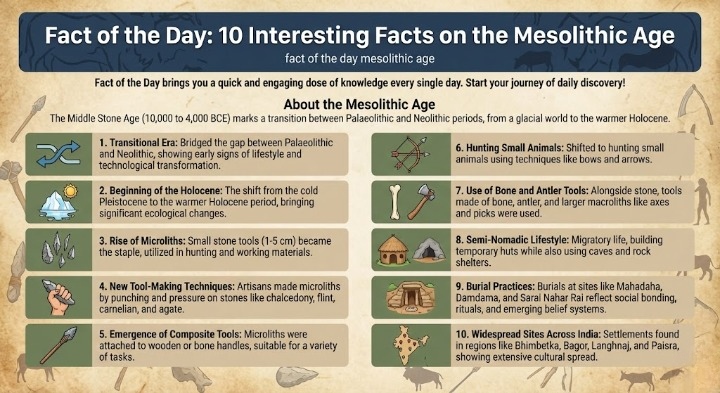Fact of the Day brings you a quick and engaging dose of knowledge every single day. With so much information in the world, this series encourages you to discover something new—whether it’s related to science, history, nature, technology, or human behaviour.
Every piece of information of our everyday life is designed to be intriguing, have some shocking facts, and reveal some very interesting information on the vast array of subjects. Cultural marvels to uncovering the truth, the little known secrets, Fact of the Day makes you a learner without any problem and always.
Start your journey of daily discovery with Fact of the Day!
Today, we’re diving into some captivating facts about the Mesolithic Age. Let’s explore this remarkable chapter of human history.
About the Mesolithic Age
The Middle Stone Age or the Mesolithic Age indicates a great transition period between Palaeolithic and Neolithic periods. It took place in India sometime around 10,000 to 4,000 BCE and marks the end of a glacial world and the start of the warmer Holocene period.
With the evolution of man to the climatic changes, he made the microliths, which were small and sharp stone tools that changed the way of hunting and daily life.
Societies resorted to hunting and gathering, but they adapted more advanced modes of hunting including bows and arrows.
Slowly these cultural and technological developments put in place the basis of early agriculture thus leading to eventual the Neolithic lifestyle.

Key Facts About the Mesolithic Age
1. Transitional Era
The Mesolithic Age bridged the gap between the Palaeolithic and Neolithic periods, showing early signs of lifestyle and technological transformation.
2. Beginning of the Holocene
This is the age when the cold Pleistocene period gave place to the warmer Holocene period that came with significant environmental and ecological changes.
3. Rise of Microliths
Microliths- small stone tools (1-5 cm in length) became the staple of this era and were utilized in hunting and in working up materials.
4. New Tool-Making Techniques
Microliths Mesolithic artisans made microliths, by punching and pressure, on such stones as chalcedony, flint, carnelian, and agate.
5. Emergence of Composite Tools
Microliths were commonly attached to a wooden or bone handle, with multiple purposes and suitable to a variety of tasks.
6. Hunting Small Animals
Individuals slowly started hunting small animals at the expense of the big ones with the help of excellent techniques like bows and arrows.
7. Use of Bone and Antler Tools
The age of Mesolithic age people, along with stone tools, bone, antler, and larger macroliths such as axes and picks were also used.
8. Semi-Nomadic Lifestyle
Usually, those who belongs from the Mesolithic groups, they lived a migratory life, also they build temporary huts while also using caves and rock shelters for their daily habitation.
9. Burial Practices
The presence of all the burials at sites like Mahadaha, Damdama, and Sarai Nahar Rai reflects the social bonding, rituals, and emerging belief systems from this period only.
10. Widespread Sites Across India
Mesolithic settlements are found across many regions—Bhimbetka in Madhya Pradesh, Bagor in Rajasthan, Langhnaj in Gujarat, Paisra in Bihar, and several others—showing extensive cultural spread.
Conclusion
The Mesolithic Age represents a crucial phase of adaptation and innovation in human history. With changing climates, growing tool sophistication, and evolving lifestyles, communities learned to use resources more efficiently. These developments eventually encouraged early farming practices, opening the path to the Neolithic Age and more settled living.
Comments
All Comments (0)
Join the conversation